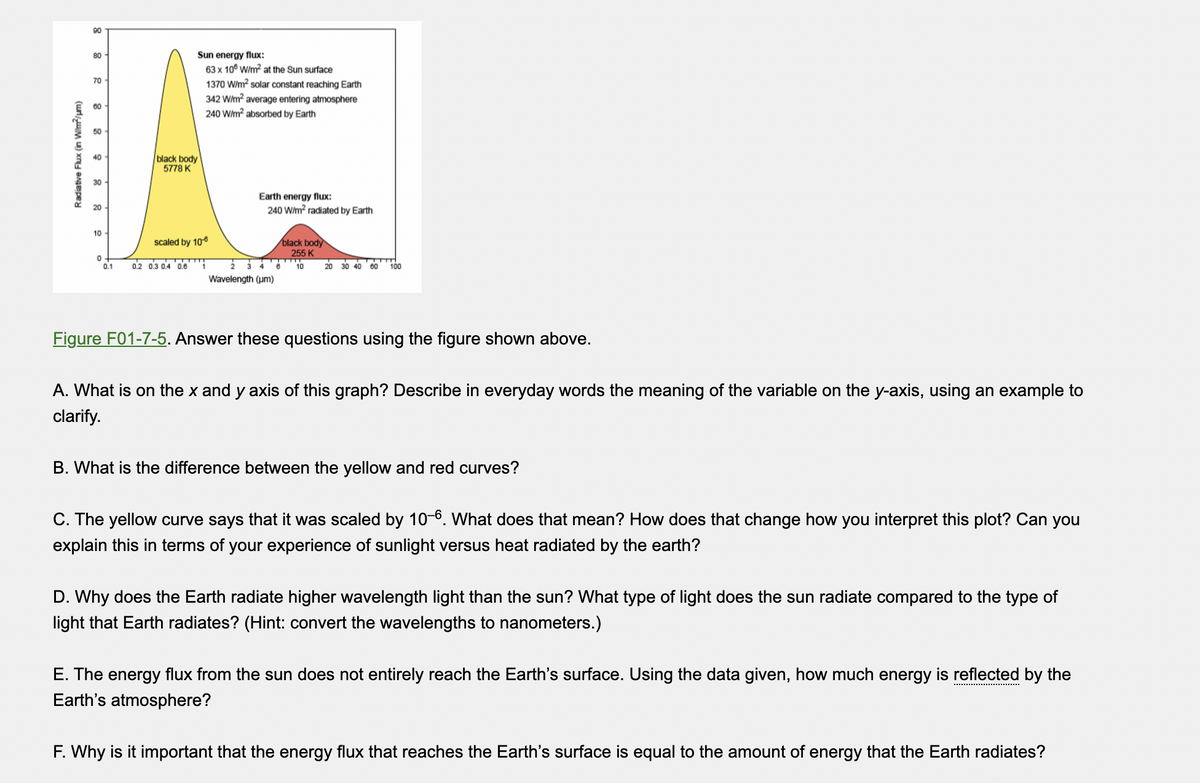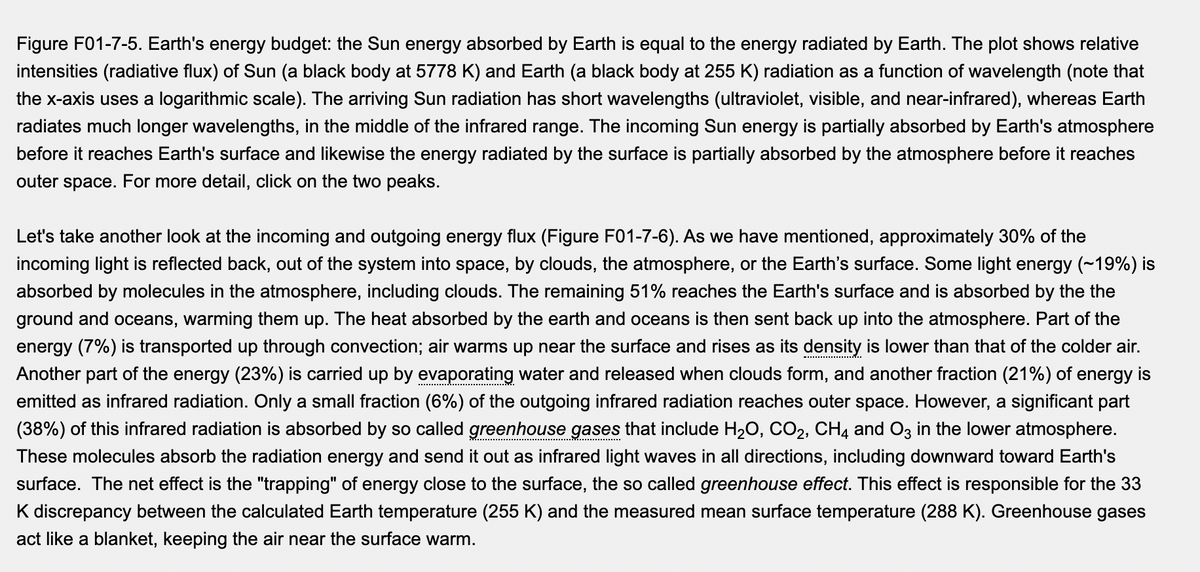A. What is on the x and y axis of this graph? Describe in everyday words the meaning of the variable on the y-axis, using an example to clarify. B. What is the difference between the yellow and red curves? C. The yellow curve says that it was scaled by 10-6. What does that mean? How does that change how you interpret this plot? Can you explain this in terms of your experience of sunlight versus heat radiated by the earth?
A. What is on the x and y axis of this graph? Describe in everyday words the meaning of the variable on the y-axis, using an example to clarify. B. What is the difference between the yellow and red curves? C. The yellow curve says that it was scaled by 10-6. What does that mean? How does that change how you interpret this plot? Can you explain this in terms of your experience of sunlight versus heat radiated by the earth?
Algebra & Trigonometry with Analytic Geometry
13th Edition
ISBN:9781133382119
Author:Swokowski
Publisher:Swokowski
Chapter5: Inverse, Exponential, And Logarithmic Functions
Section5.3: The Natural Exponential Function
Problem 40E
Related questions
Question
from a to c please
Thank you

Transcribed Image Text:90
80 -
Sun energy flux:
63 x 10° W/m? at the Sun surface
70
1370 W/m? solar constant reaching Earth
342 Wim? average entering atmosphere
240 W/m? absorbed by Earth
80
50
black body
5778 K
40
30
Earth energy flux:
20
240 W/m? radiated by Earth
10
black body
255 K
scaled by 10
0.1
0.2 0.3 0.4 0.6
10
20
30 40
60
100
Wavelength (um)
Figure F01-7-5. Answer these questions using the figure shown above.
A. What is on the x and y axis of this graph? Describe in everyday words the meaning of the variable on the y-axis, using an example to
clarify.
B. What is the difference between the yellow and red curves?
C. The yellow curve says that it was scaled by 10-6. What does that mean? How does that change how you interpret this plot? Can you
explain this in terms of your experience of sunlight versus heat radiated by the earth?
D. Why does the Earth radiate higher wavelength light than the sun? What type of light does the sun radiate compared to the type of
light that Earth radiates? (Hint: convert the wavelengths to nanometers.)
E. The energy flux from the sun does not entirely reach the Earth's surface. Using the data given, how much energy is reflected by the
Earth's atmosphere?
F. Why is it important that the energy flux that reaches the Earth's surface is equal to the amount of energy that the Earth radiates?
Radiative Flux (in Wim/um)

Transcribed Image Text:Figure F01-7-5. Earth's energy budget: the Sun energy absorbed by Earth is equal to the energy radiated by Earth. The plot shows relative
intensities (radiative flux) of Sun (a black body at 5778 K) and Earth (a black body at 255 K) radiation as a function of wavelength (note that
the x-axis uses a logarithmic scale). The arriving Sun radiation has short wavelengths (ultraviolet, visible, and near-infrared), whereas Earth
radiates much longer wavelengths, in the middle of the infrared range. The incoming Sun energy is partially absorbed by Earth's atmosphere
before it reaches Earth's surface and likewise the energy radiated by the surface is partially absorbed by the atmosphere before it reaches
outer space. For more detail, click on the two peaks.
Let's take another look at the incoming and outgoing energy flux (Figure F01-7-6). As we have mentioned, approximately 30% of the
incoming light is reflected back, out of the system into space, by clouds, the atmosphere, or the Earth's surface. Some light energy (~19%) is
absorbed by molecules in the atmosphere, including clouds. The remaining 51% reaches the Earth's surface and is absorbed by the the
ground and oceans, warming them up. The heat absorbed by the earth and oceans is then sent back up into the atmosphere. Part of the
energy (7%) is transported up through convection; air warms up near the surface and rises as its density is lower than that of the colder air.
Another part of the energy (23%) is carried up by evaporating water and released when clouds form, and another fraction (21%) of energy is
emitted as infrared radiation. Only a small fraction (6%) of the outgoing infrared radiation reaches outer space. However, a significant part
(38%) of this infrared radiation is absorbed by so called greenhouse gases that include H20, CO2, CH4 and O3 in the lower atmosphere.
These molecules absorb the radiation energy and send it out as infrared light waves in all directions, including downward toward Earth's
surface. The net effect is the "trapping" of energy close to the surface, the so called greenhouse effect. This effect is responsible for the 33
K discrepancy between the calculated Earth temperature (255 K) and the measured mean surface temperature (288 K). Greenhouse gases
act like a blanket, keeping the air near the surface warm.
Expert Solution
This question has been solved!
Explore an expertly crafted, step-by-step solution for a thorough understanding of key concepts.
Step by step
Solved in 2 steps

Recommended textbooks for you

Algebra & Trigonometry with Analytic Geometry
Algebra
ISBN:
9781133382119
Author:
Swokowski
Publisher:
Cengage

Trigonometry (MindTap Course List)
Trigonometry
ISBN:
9781337278461
Author:
Ron Larson
Publisher:
Cengage Learning


Algebra & Trigonometry with Analytic Geometry
Algebra
ISBN:
9781133382119
Author:
Swokowski
Publisher:
Cengage

Trigonometry (MindTap Course List)
Trigonometry
ISBN:
9781337278461
Author:
Ron Larson
Publisher:
Cengage Learning
